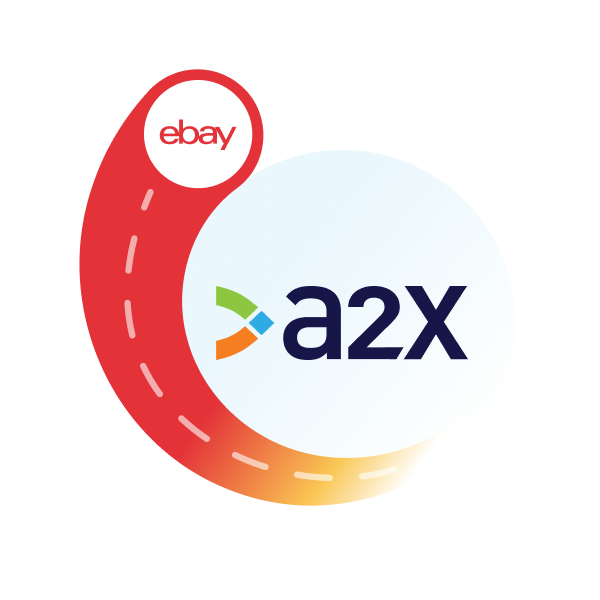eBay VAT: What Sellers Need to Know [Guide]

It’s important for eBay sellers in the UK and EU to understand the basics of VAT because it is a regulatory necessity.
Understanding VAT can help to ensure compliance with tax regulations and avoid potential fines. When managing the accounting and bookkeeping for an eBay store, accurately accounting for VAT can also help maintain proper financial records, ensuring transparent and correct financial reporting.
In this guide, we’ll break down what eBay sellers should understand about VAT, especially when it comes to accounting for VAT.
Important: A2X does not provide VAT or tax advice. The information provided in this guide is general in nature. Please consult a local tax advisor to understand VAT as it applies to your business.
Table of Contents
Integrate eBay and your accounting software for accurate accounting
A2X auto-categorizes your eBay sales, fees, taxes, and more into accurate summaries that make reconciliation in your general ledger a breeze.
`Try A2X today
Quick overview: What eBay sellers need to know about VAT
VAT (Value Added Tax) is a consumption tax placed on a product whenever value is added at each stage of the supply chain, from production to the point of sale.
When it comes to VAT, it’s important for eBay sellers to keep the following information in mind:
- In the UK, you must register for VAT and display your number on your eBay listings if you turnover more than £90,000 in sales.
- Across the EU, you must register for VAT and display your number on your eBay listings if you turnover more than €10,000 in sales.
- VAT must be collected from customers if an eBay seller is VAT-registered. eBay does not manage VAT for sellers (with the exception of transactions that fall under the Marketplace Facilitator VAT rules – more on this below), so VAT must be calculated as a percentage of the sale price of the goods sold. VAT rates can vary based on product type and country.
- VAT collected from customers must be remitted to the tax authorities. In the UK, there are a few ways to file VAT returns and remit VAT. In the EU, eBay is considered a Marketplace Facilitator and therefore must collect and remit VAT on certain transactions, under specific circumstances (more on this below).
It’s important for eBay sellers to be aware of the rules and regulations relevant to the countries where they are selling, and where they are based, to ensure compliance with local tax laws and avoid potential penalties.
Notable changes to VAT in EU and UK that impact eBay sellers
Over the past few years, there have been a few legislative changes in the UK and EU that have impacted eBay sellers and how they manage VAT.
Making Tax Digital (MTD)
Making Tax Digital requires UK VAT-registered businesses, including eBay sellers, to keep digital records and use compatible software to submit their VAT returns. Sellers must ensure they comply with these digital requirements to streamline tax filing and improve accuracy.
Brexit
As a result of Brexit, eBay sellers in the UK selling into the EU and vice versa may need to register for VAT in both the UK and EU where applicable, and understand the new rules on imports and exports between these regions.
The 2021 Ecommerce VAT Package
The 2021 Ecommerce VAT Package introduced new VAT rules for cross-border ecommerce when selling in EU, including the following:
- There is now one micro-selling exemption of €10,000 across the EU.
- Sellers have the option to consolidate their VAT filings using the OSS (One Stop Shop) system.
- The IOSS (Import One Stop Shop) system can help sellers outside the EU expedite and streamline VAT filings and the customs process.
- New regulations require marketplace facilitators to take on some of the VAT collection/remission responsibilities, where Marketplace Facilitator VAT rules are triggered.
Marketplace Facilitator VAT (MFV)
Under MFV legislation in the EU, platforms like eBay are responsible for collecting and remitting VAT on eligible sales. Sellers need to ensure their listings are updated and comply with eBay’s VAT collection processes, but they benefit from reduced administrative burdens regarding VAT on their sales through eBay.
Important note: Although MFV means that eBay might collect and remit VAT on your behalf for some transactions, you are still required to keep track of and report on VAT collected and paid.
Registering for VAT
Whether or not an eBay seller needs to register for VAT depends on their particular circumstances.
Some factors that will impact whether or not you need to register for VAT in the UK include:
- Exceeding the sales threshold – UK sellers must register for VAT if their taxable turnover exceeds £90,000 within any 12-month period. Those below this threshold can choose to register voluntarily, which can be beneficial if they want to reclaim VAT on their business expenses.
- Storing stock in the UK – If a seller outside the UK holds stock in the UK (for example, in a warehouse), you will need to register for VAT, regardless of the value of your sales.
Some factors that will impact whether or not you need to register for VAT in the EU include:
- UK sellers shipping into the EU – As the UK is no longer part of the EU since Brexit, the €10,000 exemption does not usually apply and UK sellers will normally need to register to submit EU VAT straightaway. Check with your local tax advisor on this.
- Exceeding sales thresholds – There is one distance selling threshold of €10,000 throughout the EU. If eBay sellers exceed this threshold in any country, they must register for VAT.
- Storing stock in a particular country – Regardless of sales thresholds, if an eBay seller holds stock in a particular country, they must register for VAT in that particular country.
eBay sellers can voluntarily register for VAT before meeting any of the criteria outlined above, but keep in mind that registering for VAT in any country means that you must adhere to VAT rules and regulations in the country/countries in which you are registered.
What to do once you’re registered for VAT
Once you have registered for VAT in any applicable countries, your obligations will typically include:
- Charging VAT – Sellers must charge VAT on eligible goods and services sold to customers within the UK and the EU, based on the applicable VAT rates. You will also need to add your number to your eBay account so it displays on listings (find instructions for how to do so below).
- Issuing VAT invoices – Sellers are required to provide VAT invoices to buyers who request them. These invoices should detail the VAT charged and provide other necessary information for tax purposes. Learn how to create a VAT invoice here. Learn how eBay manages invoices when they have collected VAT under MFV rules.
- Record-keeping – Sellers need to maintain accurate records of all taxable sales and purchases. These records must be kept for a minimum period (usually six years in the UK) to support VAT returns and to comply with audits.
- Submitting VAT returns – Sellers must submit VAT returns periodically (usually quarterly) to the relevant tax authorities. This involves reporting the amount of VAT they have collected from sales and the amount of VAT they have paid on their own purchases.
- Remitting VAT to tax authorities – After calculating the difference between the VAT collected on sales and the VAT paid on purchases, sellers must pay the net amount to the tax authorities. If the amount paid on purchases exceeds the amount collected, they may be eligible for a VAT refund.
- Comply with Marketplace Facilitator regulations – Depending on the regulations in the respective market, eBay may collect and remit VAT on behalf of sellers for transactions covered under the Marketplace Facilitator rules. Sellers need to stay informed about what eBay is collecting and remitting to ensure their own compliance and accurate record-keeping.
How to set up VAT on eBay
As noted above, you’ll need to charge VAT and add your VAT number to eBay if you’re registered for VAT.
VAT cannot be added after a customer has ordered something, so make sure you update listings ahead of time.
Add your VAT number on eBay
To add your number to your listings, log into your account and go to ‘Account settings’ then find ‘Site preferences’ on the left menu.
Then, scroll down to ‘Manage VAT numbers’ and click ‘Edit’.
In the pop-up, select your country and enter your VAT number, after that click ‘Done’.
Alternatively, if you have more than one VAT number, click ‘Add’ to attach another VAT number.
Once this is done, your VAT numbers will display on your listing pages under ‘Business seller information’.
Note: It is currently not possible to apply specific VAT rates to products sold on eBay. The good news? You can use A2X to help keep track of VAT rates – which is especially helpful if you sell both standard-rated and zero-rated VAT products. Read on for more information.
Keep track of VAT collected and paid
You will need to keep track of how much VAT you collect from buyers. Simply integrating your eBay Managed Payments account with your accounting software won’t do this for you, but by adding A2X into the mix, this will all be broken down automatically.
Learn more about bookkeeping for eBay VAT with A2X below – accurate bookkeeping will give you the information you need to file your VAT returns.
File VAT returns
Another obligation of VAT registration in the UK or EU is filing regular VAT returns.
For UK sellers: You must submit VAT returns – typically on a quarterly basis – to HMRC through their online portal. These returns should include details of your sales and purchases, VAT collected from customers, and VAT paid on business expenses.
For EU sellers: You must file VAT returns in each country where you’re registered, generally monthly or quarterly. Utilizing the One Stop Shop (OSS) scheme can simplify this process, allowing you to file a single quarterly return for all your EU sales.
You can file these returns yourself, or consider working with a tax professional.
Remit VAT
Under Marketplace Facilitator rules, eBay may collect and remit VAT on behalf of the seller.
If eBay collects VAT, sellers do not need to handle VAT collection and remittance for those transactions. However, sellers are still responsible for filing VAT returns and remitting VAT on sales not covered by eBay’s collection.
eBay sellers are also required to maintain records of sales where eBay has collected VAT, ensuring this is accurately reflected in their VAT returns.
For sellers directly handling VAT: Once VAT is collected and VAT payable is calculated (i.e., you’ve determined the net VAT payable by subtracting the VAT you’ve paid on business-related purchases from the VAT you’ve collected from sales), you should be ready to remit VAT.
Pay the calculated VAT due to the relevant tax authority, usually at the same time as you file your VAT return. Payment methods usually include direct debit, bank transfer, or online payment systems provided by the tax authority.
Bookkeeping for eBay VAT: Keep accurate records with A2X
Accurately accounting for eBay VAT is important for several reasons:
- You are responsible for reporting on VAT and keeping accurate business records
- You want to make sure you are not under or over-paying VAT
- You want to be prepared in the event of an audit
- You’ll get more insight into your business’s cash flow and financial position
Here are some tips for how to get it right with A2X, an ecommerce accounting automation solution.
Don’t record your eBay payout as income
eBay sellers should know that the deposit they receive from eBay isn’t just from sales. It also includes fees, refunds, VAT, and other transactions.
Recording all the money you get from eBay as just “income” or “sales” isn’t correct, and could cause problems with VAT compliance because you’re potentially recording VAT as income.
Luckily, this is exactly what A2X was designed to help solve.
Once you’ve set up your A2X account for eBay VAT, A2X will fetch payout data from eBay and categorize it according to your Chart of Accounts.
You can then send the payout information from A2X to your accounting software. A2X will create an entry in your accounting software that contains the sales, refunds, shipping income, etc.
Here’s an overview of how you can use A2X to get eBay transaction data into Xero seamlessly and accurately.
Record your VAT rates correctly
Another challenge with eBay payouts – particularly where Marketplace Facilitator VAT rules do not apply – is that they do not include specific VAT transaction line items. eBay sellers handle their own VAT and must account for it correctly, but this is particularly challenging for sellers who need to apply a specific VAT rate by country or by product type.
There are two features in A2X that are beneficial for eBay sellers when they need to split out VAT rates:
- Enable Registered Country settings in A2X – This feature allows sellers to view and map eBay transactions based on the destination country and apply appropriate tax rates. For instance, a UK seller might apply a 20% rate for sales to GB and different rates for sales to other EU countries or non-EU countries.
- Grouping by Product Type – This feature allows sellers to categorize sales of products with different tax rates. For example, a UK-based seller might have VAT on some items and no VAT on others.
Recording Marketplace Facilitator VAT
When a tax transaction triggers Marketplace Facilitator Tax rules on eBay (e.g., for some EU sales), it will be labeled “MFV” for “Marketplace Facilitator VAT” or “MFT” for “Marketplace Facilitator Tax.” A2X can separate these transactions and assign them to a dedicated current liability account on your Balance Sheet.
Even when eBay collects and remits VAT on the seller’s behalf, sellers still need to record the VAT collected for a few key reasons:
- It will help to ensure you don’t overpay VAT on your UK VAT return.
- It’s crucial for financial auditing and for providing evidence of sales and VAT collection when requested by tax authorities.
- When an eBay seller collects VAT from customers, they act as an agent for the tax authority. This VAT belongs to the government and should not be considered part of the business’s income. It is classified as a ‘current liability’ because it is due to be paid to the tax authorities within a short period (usually monthly or quarterly).
- If recorded incorrectly (e.g., as “income”), it can cause your business’s financial reports to be incorrect, which could mislead stakeholders when looking to understand the eBay store’s financial performance.
Get a step-by-step guide for how to set up A2X for eBay VAT here.
Ready to use A2X to manage eBay VAT accurately and automatically?
Start a free trial today!
Integrate eBay and your accounting software for accurate accounting
A2X auto-categorizes your eBay sales, fees, taxes, and more into accurate summaries that make reconciliation in your general ledger a breeze.
`Try A2X today




